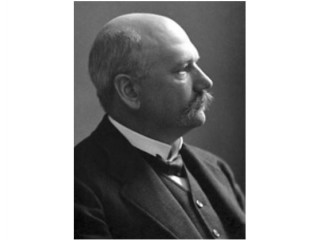
Albrecht Kossel biography
Date of birth : 1853-09-16
Date of death : 1927-07-05
Birthplace : Rostock, Germany
Nationality : German
Category : Science and Technology
Last modified : 2011-12-19
Credited as : Biochemist, Chemistry of tissues and cells, Nobel laureate
0 votes so far
Kossel was born in Rostock, Germany as the son of the merchant and Prussian consul Albrecht Karl Ludwig Enoch Kossel and his wife Clara Jeppe Kossel. As a youth, Kossel attended the Gymnasium at Rostock, where he evidenced substantial interest in chemistry and botany.
In 1872, Kossel attended the University of Strasbourg to study medicine. He studied under Felix Hoppe-Seyler, who was head of the department of biochemistry, the only such institution in Germany at the time. He attended lectures by Anton de Bary, Waldeyer, August Kundt, and Baeyer. He completed his studies at University of Rostock, and passed his German medical license exam in 1877.
Kossel showed that the substance, called "nuclein", consisted of a protein component and a non-protein component. Kossel further isolated and described the non-protein component. This substance has become known as nucleic acid, which contains the genetic information found in all living cells.
In 1883, Kossel left Strasburg to become Director of the Chemistry Division of the Physiological Institute at the University of Berlin. In this post, he succeeded Eugen Baumann and worked under the supervision of Emil du Bois-Reymond.
Kossel continued his previous work on the nucleic acids. During the period 1885 to 1901, he was able to isolate and name its five constituent organic compounds: adenine, cytosine, guanine, thymine, and uracil. These compounds are now known collectively as nucleobases, and they provide the molecular structure necessary in the formation of stable DNA and RNA molecules.
In 1895, Kossel was professor of physiology as well as director of the Physiological Institute at the University of Marburg. Around this time, he began investigations into the chemical composition of proteins, the alterations in proteins during transformation into peptone, the peptide components of cells, and other investigations.
In 1896, Kossel discovered histidine, then worked out the classical method for the quantitative separation of the "hexone bases" (the alpha-amino acids arginine, histidine, and lysine). He was also the first to isolate Theophylline, a therapeutic drug found naturally in tea and cocoa beans.
In 1901, Kossel was named to a similar post at Heidelberg University, and became director of the Heidelberg Institute for Protein Investigation. His research predicted the discovery of the polypeptide nature of the protein molecule.
Kossel was awarded the Nobel Prize in Nobel Prize in Physiology or Medicine in 1910 for his research in cell biology, the chemical composition of the cell nucleus, and for his work in isolating and describing nucleic acids. The award was presented on 10 December 1910.
In the autumn of 1911, Kossel was invited to the United States to deliver the Herter Lecture at Johns Hopkins. Traveling with his wife Luise and daughter Gertrude, he took the opportunity to travel and to visit acquaintances, one of which was Eugene W. Hilgard, professor emeritus of agricultural chemistry at the University of California at Berkeley, who was also his wife's cousin. He also visited and delivered lectures at several other universities, including the University of Chicago.
On the occasion of his visit to New York City, Kossel was interviewed by a reporter from the New York Times. Kossel's English was reportedly very good, and his self-effacing modesty is voluminously mentioned in the reporter's account.
His Herter lecture at Johns Hopkins was titled, "The Proteins". This was the only time Kossel ever visited the United States.
With his distinguished English pupil Henry Drysdale Dakin, Kossel investigated arginase, the ferment which hydrolyses arginine into urea and ornithine. Later, he discovered agmatine in herring roe and devised a method for preparing it.
Another of Kossel's students was American biochemist Edwin B. Hart, who would later return to the United States to participate in the "Single-grain experiment" (1907–1911) and be part of research teams that would determine the nutritive causes of anemia and goiter. Another was Otto Folin, an American chemist who discovered Phosphocreatine.
In 1923, Kossel was honored by being named Germany's representative to the Eleventh Physiological Congress in Edinburgh, Scotland. When he appeared before the assembled scientists, they gave him an ovation that lasted several minutes. At the congress, he was conferred an honorary degree by the University of Edinburgh.
In 1924, Kossel became professor emeritus, but continued to lecture at Heidelberg University. In April, 1927, he attended the Lister Centenary Celebration held in England.
During the last years of Kossel's life, he conducted important research into the composition of the protein types protamines and histones, and discovered flavianic acid. A monograph describing this work was published shortly after his death.
















